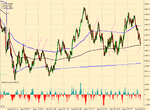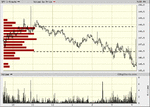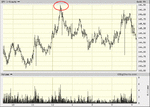Anyone got experience with Market Profile? I've been playing with it and SP500 this afternoon for 50p per point. Trying to work something out but I lost 12 points. Market's been a bit choppy this afternoon and went up. I worked out the value area, put 80% on each side of that and when it went up, shorted as I was pessimistic of the market . Sure enough it went down 7-8 points, then went up again and I lost all that, as, being pessimistic I held for a while. A new hump formed, higher up, which denoted a new, higher fair value and, of course, the 80% limit had to go higher, too. Can anyone tell me if that is the clue that a higher level is coming? and that positions should be closed when that occurs?
A new hump formed, higher up, which denoted a new, higher fair value and, of course, the 80% limit had to go higher, too. Can anyone tell me if that is the clue that a higher level is coming? and that positions should be closed when that occurs?
I'm not trading seriously as I didn't feel like it but I saw, afterwards, that a cute double bottom formed, which if I had been following normal routine, I would have acted upon. So I am wondering whether MP beats normal chartwork and whether many use it?
Split
I'm not trading seriously as I didn't feel like it but I saw, afterwards, that a cute double bottom formed, which if I had been following normal routine, I would have acted upon. So I am wondering whether MP beats normal chartwork and whether many use it?
Split



